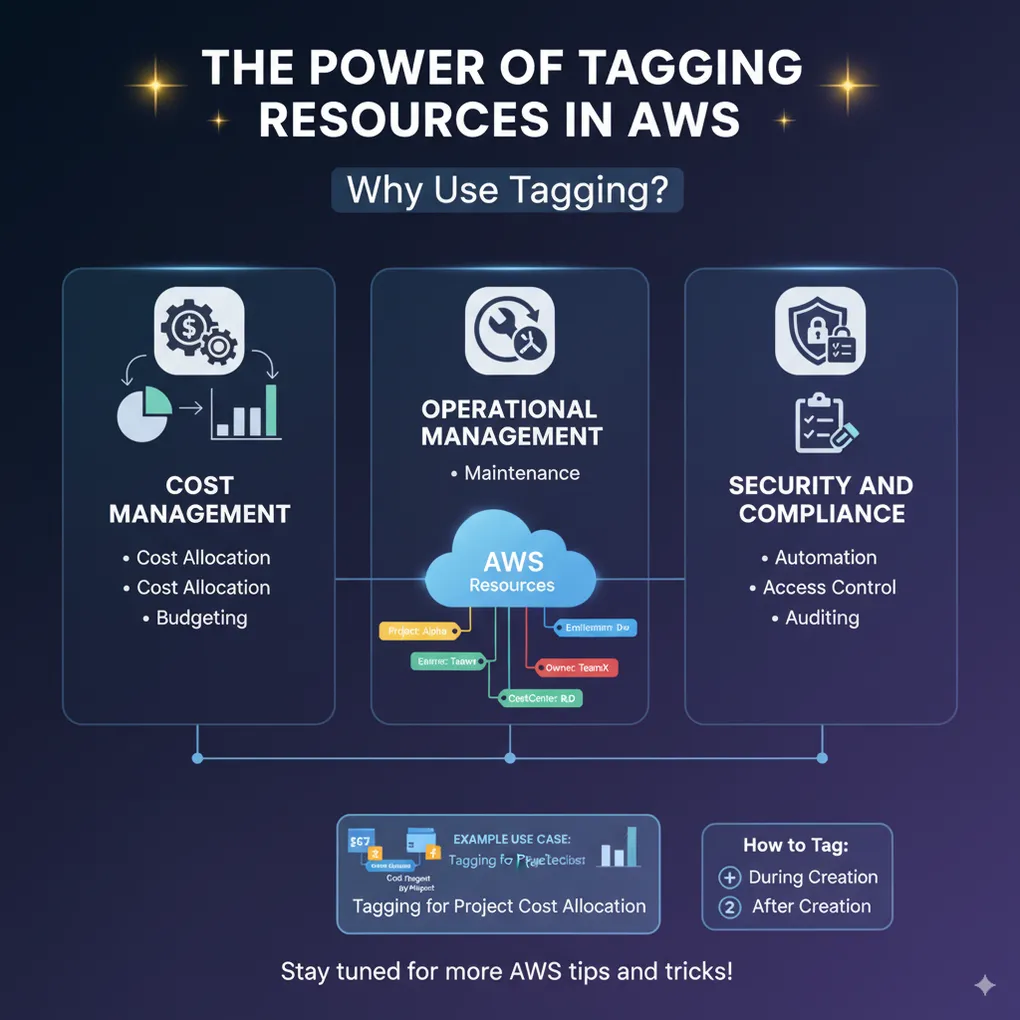
🌟 The Power of Tagging Resources in AWS
Managing cloud infrastructure at scale can quickly become overwhelming.
That’s where resource tagging in AWS comes in — a simple but powerful feature that can drastically improve how you manage, secure, and optimize your environment.
𝐖𝐡𝐚𝐭 𝐢𝐬 𝐑𝐞𝐬𝐨𝐮𝐫𝐜𝐞 𝐓𝐚𝐠𝐠𝐢𝐧𝐠?
Tagging in AWS involves assigning metadata to your resources.
Each tag consists of a key and an optional value.
For example:
Key = Project
Value = GameSafeThese tags can be used to organize, identify, and manage resources across your AWS accounts.
𝐖𝐡𝐲 𝐔𝐬𝐞 𝐓𝐚𝐠𝐠𝐢𝐧𝐠?
Tagging is much more than just labeling. Here are the key benefits:
1. Cost Management 💰
- Cost Allocation: Tag resources by project, team, or department to allocate costs accurately.
- Budgeting: Identify and eliminate underutilized or orphaned resources, reducing unnecessary spend.
2. Operational Management ⚙️
- Automation: Tags can trigger Lambda functions, EventBridge rules, or lifecycle policies.
- Maintenance: Easily filter and group resources for updates, patching, or monitoring.
3. Security & Compliance 🔐
- Access Control: Apply IAM policies based on tags to control who can access what.
- Auditing: Classify resources by sensitivity level or compliance framework (e.g., GDPR, HIPAA).
𝐄𝐱𝐚𝐦𝐩𝐥𝐞 𝐔𝐬𝐞 𝐂𝐚𝐬𝐞: Project Cost Allocation
Imagine managing multiple projects in one AWS account.
By tagging resources with a Project key:
Key = Project
Value = LearningPlatformYou can:
- Generate cost reports per project in AWS Cost Explorer
- Simplify chargeback to departments or clients
- Quickly identify resources belonging to a specific project
This makes FinOps and budgeting much easier.
𝐇𝐨𝐰 𝐭𝐨 𝐓𝐚𝐠 𝐑𝐞𝐬𝐨𝐮𝐫𝐜𝐞𝐬
You can apply tags at any point:
-
During Creation
- Add tags when creating resources via AWS Console, CLI, SDKs, or Infrastructure as Code (Terraform, CloudFormation, CDK).
-
After Creation
- Use the AWS Console or CLI to apply tags to existing resources.
- Use tag policies in AWS Organizations to enforce consistent tagging across accounts.
𝐁𝐞𝐬𝐭 𝐏𝐫𝐚𝐜𝐭𝐢𝐜𝐞𝐬 for Tagging
- Define a tagging strategy (e.g.,
Project,Environment,Owner,CostCenter). - Use consistent naming conventions to avoid chaos.
- Automate enforcement with Service Control Policies (SCPs) or AWS Config Rules.
- Periodically audit your tags to keep them clean and relevant.
Final Thoughts
Resource tagging is one of those AWS features that’s often overlooked — yet it provides huge benefits for cost optimization, security, and operational efficiency.
By building a solid tagging strategy, you not only make your cloud environment easier to manage but also unlock automation and visibility that scale with your organization.
💡 How are you using tagging in your AWS projects? Do you enforce strict tagging policies, or keep it lightweight? I’d love to hear your approach!